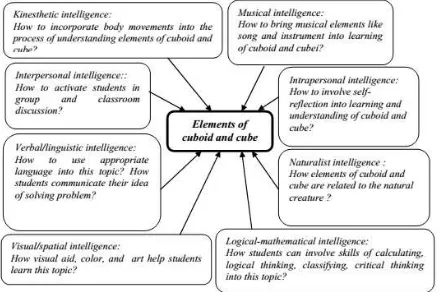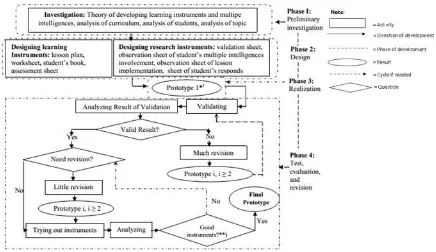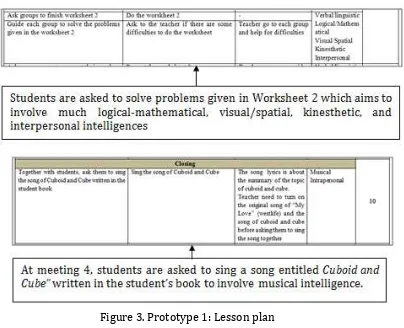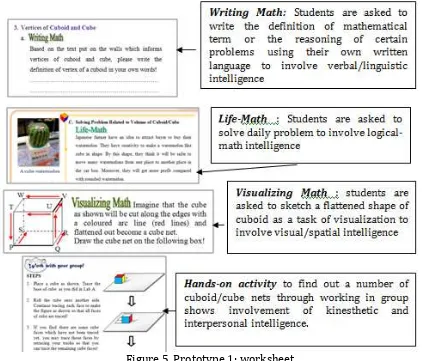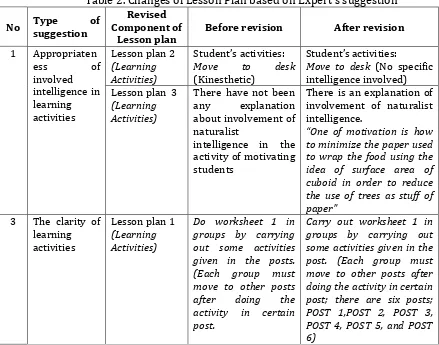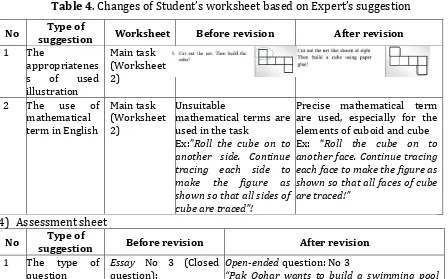20
THE DEVELOPMENT OF MATHEMATICS LEARNING INSTRUMENTS
INTEGRATING MULTIPLE INTELLIGENCES ON TOPICS OF CUBOID
AND CUBE FOR THE EIGHTH GRADE STUDENTS OFJUNIOR HIGH
SCHOOL
Ahmad Wachidul Kohar1, Abdul Haris Rosyidi2
State University of Surabaya1, State University of Surabaya1, bangwachid@gmail.com, ah_rosyidi@yahoo.com
Abstract
This study is motivated by the theory of multiple intelligences which reveal that a student will be able to learn mathematics well, if it is delivered in accordance with the intelligence that matches with his/her intelligences. Because the intelligences of students in the classroom are diverse, teachers need to use a variety of ways so that the students can also be facilitated in accordance with the intelligences they have. Therefore, it is needed mathematics learning instruments integrating multiple intelligences. This is a developmental research that uses a model of Plomp development consisting of preliminary investigation, design, realization, and phase of the test, evaluation, and revision. The objectives of this research are to describe the process and results of developing mathematics learning instruments, as well as acquire it which integrates multiple intelligences on topics of cuboid and cube for the eighth grade students of Junior High School. The instruments were trialed on 25 students at grade VIII of SMP Negeri 1 Bojonegoro year 2010/2011. The results showed that the learning instruments are categorized as good learning instruments. The instruments consisting lesson plan, student’s book, student’s worksheet, assessment sheet are valid. They are also practical shown by the average of the experts stated that it can be used by little revision, and the average of learning implementation is categorized as a good implementation. They are also effective, shown by the student’s activity of multiple intelligences involvement is effective, student’s learning outcomes is classically successful, and student’s response is positive.
Keywords: Mathematics Learning Instruments, Multiple Intelligences, Cuboid and Cube.
INTRODUCTION
Howard Gardner, a professor of Harvard School of Education has formulated the theory of multiple intelligences called multiple intelligence. In his book: Frames of Mind (1983), he mentions seven types of intelligences: verbal/linguistics intelligence, visual/spatial intelligence, logical-mathematical intelligence, musical intelligence, bodily/kinesthetic intelligence, interpersonal intelligence, and intrapersonal intelligence. Even in his last book, Intelligence Reframed (1999), he added two types of intelligences i.e naturalist intelligence and existential intelligence (Efendi, 2005: 140).
21 Each type of intelligence revealed by Gardner has unique characteristics. Verbal/linguistic intelligence is related to the ability of using and manipulating words effectively either orally or in writing. (Gardner in Suparno, 2004: 26). Meanwhile, logical-mathematical intelligence is related to the ability of using any reasons both inductively and deductively, solving abstract problems, and understanding the complex relations of things, concepts and ideas that are interlinked among one another (Bellanca, 2011: 2). Visual/spatial intelligence includes the skills of creating a graphical representation, mental images, three dimensional thinking, and create visual world (Efendi, 2005: 145).
Furthermore, musical intelligence is related to the ability of developing, expressing, and enjoying any forms of music and sound (Bellanca, 2011: 3). Bodily/kinesthetic intelligence is related to the ability of controlling and interpreting the movements of the body, setting up physical objects, and establishing a balance between body and soul (Bellanca, 2011:3). Meanwhile, interpersonal and intrapersonal intelligence respectively is associated with the person's ability to establish communication with various people and the ability of taking a personal decision. Lastly, naturalist intelligence is related to a person's ability to understand the flora and fauna well, understand and enjoy nature, and develop knowledge of the natural world (Bellanca, 2011: 4).
Basically, every student has those nine types of intelligences, but in different stressing. A student might be strong in some intelligences, but weak in the other types of intelligences. For instance, a student might be strong in kinesthetic intelligence but weak in logical-mathematical intelligence. Nevertheless, this weakness of the intelligences could actually be repaired through education. Education should help students to encourage each intelligence grows optimally. Therefore, learning activities conducted at school should be designed by considering
a variety of student’s intelligences. This idea is similar with Gardner’s statement
saying that although students are only dominant on some intelligences, they could actually be helped through education by teacher’s help to develop other intelligences so that those can be used for life more comprehensively (Gardner in Suparno, 2004:15).
Based on the theory of multiple intelligence, a student can learn a lesson well when it is delivered according to intelligence that matches with his/her intelligence. For example, a student who is dominant in kinesthetic intelligence will be able to learn mathematics easily if it is taught and served in expression of physical movement.
Because student’s intelligence in the classroom variegated, teachers need to use various methods representing many kind of intelligences so that every student can be assisted according to intelligence they have.
In fact, the practice of learning in the classroom does not fully support the diversity of
student’s intelligence. Teachers tend to teach in accordance with the intelligence that
stand out on him/her or according to kind of intelligence which are much involved in lesson being taught. For example, some mathematics teachers tend to deliver the lesson by asking students to solve any mathematical problems much abstractly which involve more logical-mathematical intelligence than other types of intelligence might
be involved in learning, whereas Adams said, Each child may use a variety of these intelligences to learn mathematics concept and skills, not just the
22 important thing in learning practices is that teachers should be able to recognize and preserve the diversity of students' intelligence because they have different combinations of intelligences. By this way, every student will be more appreciated in terms of their intelligences so that they are motivated to learn any lessons.
Conducting mathematics learning integrating multiple intelligences, teachers need to think how a topic can be transformed into the form of intelligences as many as possible. Mathematical concepts and skills can be delivered in the form of written or oral language, pictures, musical expression, physical movement, social interaction, self-reflection, even natural world. This is in line with Armstrong’s statement (2009:64) saying that the best way to approach curriculum using the theory of multiple intelligences is by thinking about how one can translate the material to be taught from one intelligence to another.
Integrating multiple intelligences into mathematics learning also needs instructional
instruments, such as lesson plan, student’s book, student’s worksheet, and assessment sheet. All the instruments are expected to work simultaneously to support learning activities. In term of designing lesson integrating multiple intelligences, Armstrong (2009:65-67) gives idea of creating lesson integrating multiple intelligences as described below.
1. Focus on a specific objective or topic. This study focuses the topics of cuboid and cube talking about elements and properties of cuboid and cube, nets of of cuboid and cube, surface areas of cuboid and cube, and volumes of cuboid and cube
2. Ask key MI (Multiple Intelligences) question. The emerging questions should only ask on focused topic or learning objective which is put on the center like in the figure as an example below.
Figure 1.MI Planning Questions for the topic of elements of cuboid and cube.
3. Consider the possibilities. Make some schemes showing possible activities based on the figure 1. For instance, the possible activities to understand the topic of cuboid and cube written on the table below.
Table 1. MI Possibilities for the topic of elements of cuboid and cube
Intelligences Possible Activities Tools
verbal/linguisti c
Restate the definition of cuboid and cube using personal language, use communication skill to present group’s work result
Student’s worksheet
logical-mathematical
Classify things around classroom included in the shape of cuboid or cube, then calculate the
23
Intelligences Possible Activities Tools
measurement of those elements student’s book visual/spatial Draw cuboid and cube and determine their elements,
represent problems using picture/diagram
Colored pencil, ruler, student’s book
Kinesthetic Move to find out information about elements of cuboid and cube put on the walls in the classroom to solve problems given on the worksheet, hold
hands-properties of cuboid and cube
Student’s book, speaker, laptop Interpersonal Work in group to discuss problem given in the
worksheet
-
Intrapersonal Write weakness, advantages and difficulties of understanding elements of cuboid and cube at the end of the lesson
Reflection card
Naturalist Find some objects around the classroom which are in the form of cuboid and cube, then determine their measurements
-
4. Brainstorm. Think more possible activities which are appropriate with the topics in order to obtain many more intelligences which could be involved into learning activities.
5. Select appropriate activities. Choose several appropriate activities which mostly possible to conduct in the process of learning by considering the time needed. 6. Set up a sequential plan. Put the chosen activities in the right order which are
then arranged into lesson plan. After that, write the tools required which could
support learning process such as worksheet, student’s book, and assessment
sheet.
7. Implement the plan. Conduct the learning using lesson plan which have been created. The teacher can modify the learning process according to the student’s feed-back.
From the description above, the researcher considered that it was important to
develop learning instruments consisting of lesson plan, student’s book, student’s
worksheet, and assessment sheet integrating multiple intelligences through the
research entitled, The Development of Mathematics Learning Instruments Integrating Multiple Intelligences on Topics of Cuboid And Cube For The Eighth Grade Students Of Junior (igh School . This study aims to describe the process and the result of developing learning instruments, and also obtain the learning instruments integrating multiple intelligences on topics of cuboid and cube.
Method
This is a developmental research. The model of development used in this study is
Plomp’s model consisting of preliminary investigation; design, realization,
24 assessment sheet) are categorized as good instruments if they satisfy aspects of validity, practicality, and effectiveness. Figure 2 below shows a flowchart of developing learning instruments.
Figure 2. Flowchart of developing learning instruments
RESULT AND DISCUSSION
1. Phase of Preliminary Investigation
Researchers used the framework of designing lesson integrating multiple intelligence from Armstrong (2009) and theory of Multiple Intelligences by Gardner (2003) as fundamental theory in developing learning instruments. Analysis of the students was done by examining the characteristics of students in accordance with the development plan of learning. Every student has some types of dominant intelligence to learn something. This potential is possessed by each student with a different range of intelligence. Hence, it requires a learning design involving intelligence as much as possible so that every students is facilitated to learn. For those who are weak in certain intelligence, the learning design is useful to develop other intelligences so that it will be useful for their thorough life.
25 2. Phase of Design
There are two objects developed in this phase: learning instruments and research instruments like shown in figure 2. Lesson plans are designed in four meetings discussing: (1) elements and properties of cuboid/cube; (2) nets of cuboid and cube; (3) surface areas of cuboid and cube; (4) volumes of cuboid and cube. Lesson plan describes introduction, main activities, and closing for each meeting completed with the explanation of involved intelligences. Meanwhile, to give special features on
student’s book integrating multiple intelligences, there are some special features written in the book such as Word Smart (find out some mathematical terms in a box of puzzle to involve verbal/linguistic intelligence), Real-Life Math (solve problems represented the relationship between natural/daily life and cuboid/cube to involve naturalist and logical-mathematical intelligence), Critical Thinking (solve mathematical problems which supports critical thinking to involve logical-mathematical intelligence), Let’s sing math song (sing a cuboid/cube song to involve musical intelligence), and Mapping Your Thinking (create mind-mapping as a diagram used to visualize outline learning of cuboid/cube to involve visual/spatial and intrapersonal intelligence).
Some features of multiple intelligences involvement in the worksheet are shown through a series of tasks which must be solved by students such as Writing Math (write verbal answer like giving any reasons to involve verbal/linguistic intelligence),
Drawing Math (make representation of the answer like picture or diagram) and Visualizing Math (draw the flattened shape of cutting cuboid/cube as a result of visualization to involve visual/spatial intelligence), Life-Math (solve daily life problems to involve naturalist and logical-mathematical intelligence), and the other tasks which show the involvement of kinesthetic and interpersonal intelligences implicitly through the tasks such as holding hands-on activity and working in group. On the other hand, kind of assessment developed is written test which deliberately involves verbal/linguistic, logical-mathematical, and visual/spatial intelligences.
3. Phase of Realization 1) Lesson Plan
Some types of intelligences involved in activities are shown like below.
26 Figure 3. Prototype 1: Lesson plan
2) Student’s Book
Some types of intelligences involved in the features in the student’s book are shown like below.
Figure . Prototype : student’s book
3) Student’s Worksheet
27 Figure 5. Prototype 1: worksheet
4) Assessment Sheet
Some types of intelligences involved in the written test given to the students after meeting 4 are shown like below.
Figure 6. Prototype 1: Assessment sheet
4. Phase of Test, Evaluation, and Revision
In this phase, there are two activities conducted: validating learning instruments and trying out learning instruments to the research subjects. The description of those activities is given as follows.
a. Validating learning instruments
28 theory of multiple intelligences, and language used in the instruments, and a mathematics teacher who focused on the level of mathematical content and activities to the student’s ability. The result of score of validation comes from the average score from those three experts and then it is classified into category based on criteria of validity on learning instruments by Khabibah (2006) as shown below,
≤ ≤ : vey valid
≤ < 4 : valid
≤ < 3 : less valid
≤ < 2 : not valid Note:
= Average score of validity on learning instruments
A learning instruments is said to be valid if the average validity of instruments in criteria of valid or very valid. The result shows that the average values of validation
given by experts to lesson plan is , valid , student’s book is , valid , student’s
worksheet is 4,02 (very valid) for, and the average value of assessment sheet is 3,86 (valid).
Beside giving judgment, the experts also give advice on improvements to the instruments being developed. Here are some changes based on suggestions from the experts.
1) Lesson plan
Table . Changes of Lesson Plan based on Expert’s suggestion
No Type of
suggestion
Revised Component of
Lesson plan
Before revision After revision
1 Appropriaten involvement of naturalist intelligence.
One of motivation is how
29
Before revision After revision
Lesson plan 1,2,3,4
There has not been a clear division between the learning activities written in the lesson plans
There are three main part of activities : (1)Introduction, (2) Main Activities, (3) Closing
2) Student’s book
Table . Changes of Student’s book based on Expert’s suggestion
No Type of
Before revision After revision
1 The balance
Precise mathematical term are used ,especially for the topics of cuboid and cube
3 Form of explanation
Main content Some explanation seems do not involve much student’s thinking, because they are too clearly served
Reduce explanation and transform explanation into the form of student’s task carried out in worksheet
3) Student’s worksheet
Table 4. Changes of Student’s worksheet based on Expert’s suggestion
No Type of
suggestion Worksheet Before revision After revision
1 The
mathematical terms are used in the task
Ex: Roll the cube on to another side. Continue tracing each side to make the figure as shown so that all sides of
cube are traced !
Precise mathematical term are used, especially for the elements of cuboid and cube Ex: Roll the cube on to another face. Continue tracing each face to make the figure as shown so that all faces of cube
are traced!
4) Assessment sheet
No Type of
suggestion Before revision After revision
30 consecutively is 18 m, 8 m, and 2 m, and a tin of swimming pool is not more than 3 m, what possible dimensions which can be chosen by Pak Qohar? (mention only two possible dimensions).Hint: (Dimension : a length, a width, and a height of swimming pool) 2. If a tin of paints costs Rp20.000,00, how
much is the minimum cost needed by Pak Qohar to buy the paints (Choose only a
dimension that you found in 3a
b. Trying out learning instruments
)n this step, the data of learning implementation, student’s activities of multiple intelligences involvement, student’s learning outcome, and student’s
responds are gained. Prototype 2 as results of validation was used in the class where the try out of instruments was trialed on.
One of criteria on practicality is learning implementation. The score of learning implementation comes from the average score from two observers observing learning activities in four meetings and then it is classified into category based on criteria of learning implementation by Khabibah (2006) as shown below.
≤ ≤ : vey good ≤ < 4 : good 2 ≤ < 3 : less good
≤ < 2 : not good Note:
= Average score of learning implementation using the learning instruments being developed
Here, the learning implementation is said practical if it is in the criteria of good or very good. The results show that learning implementation is categorized as a good implementation based on average total of 3,95 (good). On the other hand, the total percentage of activity on involved multiple intelligence is 89,46%. It shows that multiple intelligences were successfully involved by students nearly all the time of
learning so that the activity of students is said to be effective. )n addition, student’s
score of learning outcome shows that 88% of students passed the minimum targeted score (75 out of 100). On the other hand, more than a half of items of questionnaire is categorized as strong responds. It can be concluded that the learning instruments obtain positive responds from the students.
CONCLUSION
The development of learning instruments was conducted using Plomp’s model of
31 average total of validation given by experts shows that instruments are valid (lesson
plan , , student’s book , , worksheet , , assessment sheet , ;
practicality, shown by expert’s review stating that the learning instruments are practical and average total of learning implementation in the classroom is 3,85 (good); and (3) effectiveness, shown by student’s activities of multiple intelligences involvement is effective with percentage of , %, student’s learning outcome is classically successful (88% of students passed the minimum targeted score (75 out of
, and student’s responds to the learning instruments is positive. (ence, the
learning instruments which have been developed in this study is final prototype.
REFERENCES
Adams, T.L. (2001). Helping Children Learn Mathematics Through Multiple Intelligence and Standards for School Mathematics. ProQuest Education Journals, (Online),
Volume 2, No. 77,
(http://ici-bostonready-pd-2008-2009.wikispaces.umb.edu/file/view/10+C+Helping+Children+Learn+mathemat ics+Through+MI.pdf, accessed on 10 Januari 2011).
Armstrong, T. (2009). Multiple Intelligences in The Classroom. Third Edition. Virginia USA: ASCD.
Bellanca, J. (2011). 200+ Strategi dan Proyek Pembelajaran Aktif untuk Melibatkan Kecerdasan Siswa. 2nd ed.. Translated by Siti Mahyuni. Jakarta: Indeks.
Efendi, A. (2005). Revolusi Kecerdasan Abad 21. Bandung: Alfabeta.
Gardner, H. (2003). Multiple Intelligence : Kecerdasan Majemuk, Teori dan Praktek. Batam: Interaksara.
Gunawan, A. W. (2003). Genius Learning Strategy. Jakarta: Gramedia Pustaka Utama.
Khabibah, S. (2006). Pengembangan Model pembelajaran Matematika dengan Soal Terbuka untuk Meningkatkan Kreativitas Siswa Sekolah Dasar. Surabaya: Disertasi. Tidak dipubliksikan. Doktoral Universitas Negeri Surabaya.
Nievenn, N. (1999). Prototyping to Reach Product Quality. p.125-135. From Design Approaches and Tools in Education and Training. Van den Akker, Jan.et.al. Dordrecht, the Netherland: Kluwer Academic.
Rochmad. (2009). Pengembangan Model Pembelajaran Matematika Beracuan Konstruktivisme yang Melibatkan Penggunaan Pola Pikir Induktif-Deduktif (Model PMBK-ID) untuk Siswa SMP/MTs. Surabaya: Disertasi Doktoral Universitas Negeri Surabaya.
Suparno, P. (2004). Teori Inteligensi Ganda dan Aplikasinya di Sekolah. Yogyakarta: Kanisius.
This paper can be cited as Zulkardi(2013). Proceeding The First South East Asia Design/Development Research (SEA-DR) International
